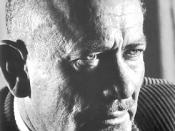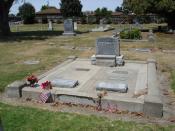A pre-adolescent boy raised on a ranch during the early 1900s period experiences hope, attachment, disappointment, death, grief, and family discord, as well as the delight and irrelevance of the aged in John SteinbeckÃÂs The Red Pony. The book is short and consists of disjointed chapters with no real connection to each other except for the same setting and mostly the same characters. Yet the book is engaging and provides a keen view of what life must have been like during the first part of the twentieth century in the rural western United States.
Each chapter in The Red Pony captures the readerÃÂs attention with a new and thoughtful situation in the boyÃÂs youth. However, unlike most other books, none of the chapters refers to the other. Conflicts that seem to have been unresolved in the previous chapter not only remain unresolved, the later chapters proceed as if these previous conflicts never existed.
The reader can be left wondering about this strange writing technique, until further investigation reveals that The Red Pony was not written as one cohesive book but rather as four separate short stories, ÃÂThe Gift,ÃÂ ÃÂThe Great Mountains,ÃÂ ÃÂThe Promise,ÃÂ and ÃÂThe Leader of the People.ÃÂÃÂThe GiftÃÂ is a ÃÂsimply toldÃÂ story about a boy, Jody, whose father buys him a pony. Published in November 1933, the story is SteinbeckÃÂs adaptation of his own story, beginning when he was 4 years old and had the opportunity to take care of a pony while Steinbeck was living on the Hamilton Ranch near King City with his Uncle Tom. Steinbeck remembered ÃÂthe most tremendous morning in the world when my pony had a cold.ÃÂ In the story, Jody learns that the family ranch hand is not infallible as the pony becomes sick and dies. ÃÂThe Great Mountains, the bookÃÂs second chapter, is the story about an elderly Indian who ÃÂcomes homeÃÂ to the ranch to die. It was published as a separate short story in December 1933. Jody is enamored of the Indian for his knowledge of the mountain range about which Jody has dreamed of adventure. The birth of a colt is the focus of the third chapter, ÃÂThe Promise,ÃÂ published in a magazine in August 1937. In the story, Jody waits, sometimes patiently and sometimes not, for the coltÃÂs birth. When the time comes, the colt is in the breach position, and the ranch hand is forced to crush the mareÃÂs skull so that he can cut the colt from her body. In ÃÂThe Leader of the People,ÃÂ JodyÃÂs maternal grandfather arrives for a visit and launches into a monologue of stories from his younger days, much to the annoyance of JodyÃÂs father, who has heard the stories many times. The grandfather overhears his son-in-law complain about the tediousness involved in hearing the stories ÃÂover and over again.ÃÂ The embarrassed grandfather retreats, but Jody follows and insists on making his grandfather some lemonade to enjoy while Jody can listen to the stories. ÃÂThe Leader of the PeopleÃÂ was published in August 1936, before ÃÂThe Promise.ÃÂ It was not until a year later, in 1938, that the four short stories were published together as four chapters in one book.
Thus, SteinbeckÃÂs strange writing ÃÂtechniqueÃÂ in The Red Pony, four seemingly unrelated chapters, was not a technique at all, but the result of publication decisions with respect to four separate short stories. The publication decisions, as well as the context learned from SteinbeckÃÂs early life, are helpful in analyzing The Red Pony in terms of theme and symbolism.
Common characters to each story are Jody Tiflin, the boy; his father, Carl Tiflin; the boyÃÂs mother and CarlÃÂs wife, identified only as Mrs. Tiflin; and Billy Buck, the familyÃÂs ranch hand. The only other characters of any consequence are Gitano, the old Indian, and JodyÃÂs grandfather. Although Jody does attend school, the childÃÂs relation to school is described only in terms of his walk to and from school and daydreams during which Jody imagines his classmates envious of his ownership of and relationship to a fabulous stallion. During much of the story lines, JodyÃÂs companions are the domesticated animals on the ranch and surrounding wildlife. The dogs chase chickens and burrow for squirrels. It has been opinionated that the dogs represent childhood. The interpretation is reasonable one, but given the context in which the story was written ÃÂ SteinbeckÃÂs recollection of his experience with a sick pony on his uncleÃÂs ranch ÃÂ the dogs likely are included to give depth to JodyÃÂs living experience. If symbolism must be attributed to them, they are more likely representative of the loneliness and the source for escape from boredom that would be a part of every day spent without the companionship of peers.
In ÃÂThe Great Mountains,ÃÂ Jody is setting mouse traps which he knows will be ÃÂ and is ÃÂ sprung on his dogÃÂs nose. Scolded by his mother, Jody ÃÂfelt mean,ÃÂ so he picks up a slingshot, finds a stone ideal for the toy, and, slinging the stone into the air, strikes and kills a bird. Jody is unconcerned inflicting death on the bird, but he does worry about how adults will view the action. The bird is the victim of JodyÃÂs displaced rebellion, but it is another symbol of loneliness and escape from boredom, as well as frustration at being scolded. JodyÃÂs reaction to its death at his hands demonstrates that Jody remains immature, not empathizing with another living creature but ever aware of reproachful adults.
Jody gazes at the mountains with curiosity and longing. He wants to know what is beyond them. His father tells him that beyond the mountains are more mountains, and still more, until then there is the ocean. The mountains are symbolic of ÃÂadventure and independence,ÃÂ according to one observer. Like the bird, they represent a possibly escape from boredom, mystery, and the possibility of adventure. Most of the unknown would represent the same to a bored boy with no children with whom to play.
Gitano arrives unexpectedly. He is elderly, returned to the general area of his birth, which includes the ranch, because ÃÂI was born here, and my father, too.ÃÂ He captures JodyÃÂs attention when he tells him that he has been to the mountains when he was a boy, but reveals little about what can be found there. Gitano does not directly say, but it is clear that he has returned to the area of his birth to die. He is too old to work, he says. He encounters Easter, an aged horse, and comments that the horse is ÃÂ[n]o good any more . . . . Too old to work . . . . Just eats and pretty soon dies.ÃÂ JodyÃÂs father tells Gitano that ÃÂ[o]ld things ought to be put out of their miseryÃÂ. Carl glances at Gitano to gauge whether the old man has detected the parallel between Easter and Gitano. The parallel is indeed unmistakable. Easter represents old age, irrelevance, and near death.
Later that evening, after Gitano has dinner with JodyÃÂs family, Gitano retreats to the bunk house. Jody follows, eager to talk about the mountains. He surprises Gitano, who tries unsuccessfully to hide the rapier he holds. He explains to Jody that he obtained it from his father, and that he does nothing with it except ÃÂjust keep it.ÃÂ Without realizing it, Jody has caught a glimpse into GitanoÃÂs soul. The rapier is a symbol of the old manÃÂs relevance and his connectedness to humanity, even if it is only through his own deceased father.
JodyÃÂs maternal grandfather appears unexpectedly for a visit in ÃÂThe Leader of the People.ÃÂ In his youth, the grandfather had held a responsible position leading a wagon train of pioneers on their journey during the westward expansion of the United States. Now elderly, the grandfather enjoys telling stories of the dangers and accomplishments of that time. Carl, who has heard the stories many times, is weary of them and annoyed with his father-in-law. At the breakfast table, unaware that JodyÃÂs grandfather is just outside the kitchen within hearing distance, Carl complains openly about having to continue to listen to details about a time that is ÃÂfinished.ÃÂ When the grandfather reveals his presence, he, Carl, and Billy are embarrassed, Mrs. Tiflin is horrified, and Jody just wants to make things better. He follows his grandfather to the porch and tried to engage him in a favorite activity (chasing mice), but the old man declines. As he muses that perhaps Carl is right, the exciting times of his younger days are indeed past, Jody tries to comfort his grandfather with an offer of homemade lemonade. GrandfatherÃÂs stories signify the human need to matter, to be relevant. The lemonade is a symbol of empathy, and the need for the connectedness that comes from family.
JodyÃÂs childhood was likely much like that of most children during the early 1900s. His parents clearly loved him. However, the work of just surviving on a rural farm consumed much time, and his parents therefore seemed to have little time to simply interact with Jody. The role of JodyÃÂs mother seems to be to provide for meals, with little other interaction. JodyÃÂs father is harsh, and Jody seems to have a dose of fear for him. Other than boredom, JodyÃÂs experiences are so different from my own, that there really is nothing with which I can identify. Works CitedReed, Arthea J.S. ÃÂA TeacherÃÂs Guide to the Penguin Edition of John SteinbeckÃÂs The Red Pony.ÃÂ 9 April 2008 .
Steinbeck, John. The Red Pony. 1945. New York: Penguin, 1992. 1-37.
ÃÂThe Red Pony.ÃÂ steinbeck.org. 5 June 1990. Steinbeck Center. 9 April 2008 .


